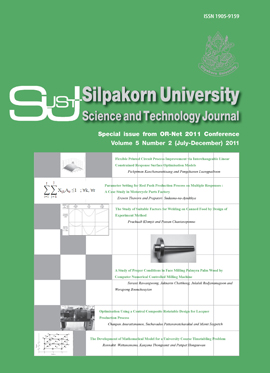A Study of Proper Conditions in Face Milling Palmyra Palm Wood by Computer Numerical Controlled Milling Machine
Main Article Content
Abstract
The purpose of this research was to investigate the effects of main factors on the surface roughnessin milling process of Palmyra Palm wood face by computer numerical controlled milling machine and usingshell end mill cutting tools 6 edges. The main factors including speed, feed rate, depth of cut and angle of cutwere investigated for the optimum surface roughness. Generally, acceptable surface roughness was between3.0-9.0 μm before sanding process. In the experiment, Palmyra Palm wood of 11-13% humidity was used at800-1200 rpm in cutting speed and feed rate at 0.03-0.05 mm/tooth. The result of preliminary trial showedthat the depth of cut and the angle of the cut had no effect on surface roughness. It was found from theexperiment that the factors affecting surface roughness were feed and speed, with tendency for reduction ofroughness value at a lower feed rate and greater cutting speed. Therefore, in the facing process for PalmyraPalm wood it was possible to determine a face milling condition by means of the equation Ra=0.954+20.4feed+0.00126 speed. This equation was employed at a limited speed of 800-1200 rpm, and the feed rate of0.03-0.05 mm/tooth. The result from the experiment of the mean absolute percentage error of the equationof surface roughness is 6.10% which is less than the margin of error, and is acceptable.
Downloads
Article Details
References
Arlai, T., Kaewtatip, P., and Prommul, K. (2003). Influencs of various working parameter in routing process of rubber wood using tungsten carbide routers. ME-network National Conference Phuket, Thailand: 74-79.
Bagci, E. and Aykut, S. (2006). A study of taguchi optimization method for identifying optimum surface roughness in CNC face milling of cobalt-based alloy (stellite 6). International Journal of Advanced Manufacturing Technology, 29(9-10): 940-947.
Bailey, J. A., Bayoumi, A. M. E., and Stewart, J. S. (1983). Wear of some cemented tungsten carbide tools in machining oak. Wear, 85: 69-79.
Bayoumi, A. M. E. and Bailey, J. A. (1985). The role of tool composition and tool geometry in controlling the surface finish in machining of Wood. Wear, 103: 311-320.
Routara, B. C., Bandyopadhyay, A., and Sahoo P. (2009). Roughness modeling and optimization in CNC end milling using response surface method : effect of workpiece material variation. Journal of Advanced Manufacturing Technology, 40(11-12): 1166-1180.
Miklaszewski, S., Beer, P., Zbie, M., Wendler, B. G., Mitura, S., and Michalski, A. (2000). Micromechanism of polycrystalline cemented diamond tool were during milling of wood-based materials. Journal of Diamond and Related Materials, 9: 1125-1128.
Montgomery, D. C. (2005). Design and analysis of experiments, 6th ed., New York: John Wiley & Sons.
Ploypanichjaroen, K. (2003). Engineering Statistics Volume 2. Minitab processed, 4th ed., Bangkok: Technology Promotion Association (Thai-Japanese).
Prommul, K., Kaewtatip, P., and Arlai, T. (2002). Study on optimum wood cutting condition using PCD. ME-network National Conference Phuket, Thailand: 526-530.
Rawangwong, S. and Chatthong, J. (2007). The study favorable conditions for the cutting text on para wood by computer numerical controlled milling. IE-network National Conference Phuket, Thailand: 121-129.
Rawangwong, S. and Chatthong, J. (2008). The study of proper conditions for Palmyra Palm wood turning by carbide cutting tool. IE-network National Conference Songkhla, Thailand: 787-795.
Rawangwong, S., Chatthong, J., Rodjananugoon, J., and Jaidumrong, J. (2010). The study favorable conditions for text engraving on coconut wood using computer numerical controlled milling machine. IE-network National Conference Ubon Ratchathani, Thailand.
Rawangwong S., Chatthong, J., and Rodjananugoon, J. (2011). The study of proper conditions in face coconut wood by CNC milling machine. IEEE International Conference on Quality and Reliability (ICQR) Bangkok, Thailand: 455-459
Sutus Na Ayuthaya, P. and Luengpaiboon, P. (2008). Design and analysis of experiment, Top publishing, Bangkok.
Thalabnark, D. (2000). Palmyra palm tree and Its values, Petchburi Rajabhat University printing, Petchburi.
Yang, Y. K., Chuang, M. T., and Lin S. S. (2009). Optimization of dry machining parameters for high-purity graphite in end milling process via design of experiments methods. Journal of Materials Processing Technology, 209: 4395-4400

